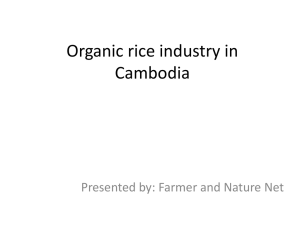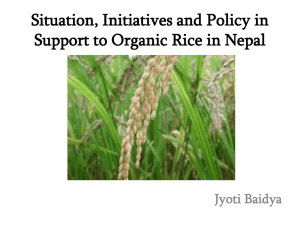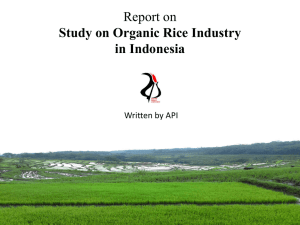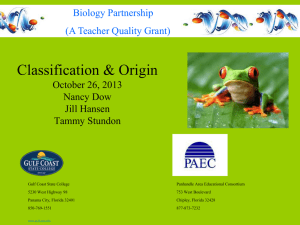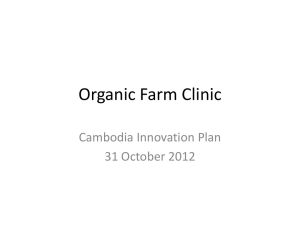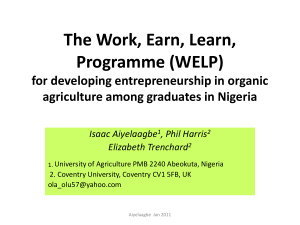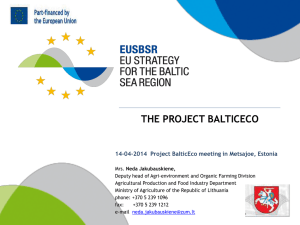ORGANIC RICE INDUSTRY in the PHILIPPINES
advertisement
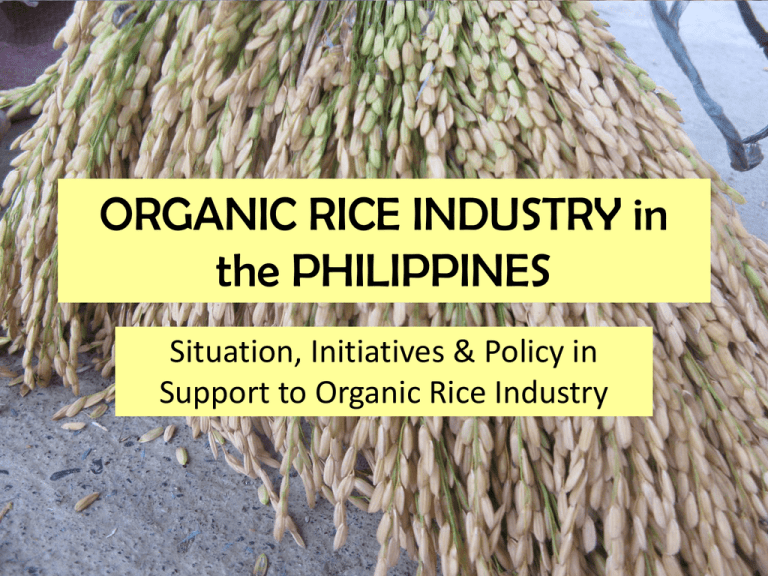
ORGANIC RICE INDUSTRY in the PHILIPPINES Situation, Initiatives & Policy in Support to Organic Rice Industry Organic Rice Industry updated 3/1/12 Total number of arable lands (has): 4.8 M Rice Area : (has) 4.27 M as of 2007 Province Number of farmers Number of hectares Abra Aurora* 15 20 20 5 Bicol (pakisama)* Camarines Sur Catanduanes Ifugao Isabela* Mindoro* Quezon Nueva Ecija Pangasinan Sorsogon Tarlac Bohol Guimaras Iloilo Negros Occidental Agusan del Sur Agusan del Sur (talacogon)* Bukidnon Davao del Norte Davao del Sur Davao Oriental Misamis Oriental North Cotabato South Cotabato Zamboanga del Sur Total Philippines 130 217 40 30,000 20 25 33 620 25 90 37 50 56 370 264 141 60 105 200 182 18 15 4,090 91 50 37,064 130 223 8 10,000 6 37 8 328 12 42 60 30 60 439 130 135 60 87 45 327 5 15 2,069 95 400 14,776 Key issues and problems • Drop in yield during conversion • Limited support to organic production (organic seeds, fertilizer, technology, pre and post harvest facilities, seed banks, demo farms, R&D) • Production financing • Only handful of organizations into marketing Key issues and problems • Organic rice still production driven than market driven • Market capitalization • Certification Key issues and problems • On policy, needs to be vigilant on the implementation of OA Program • Limited studies about OA initiatives • Capability building for farmers and DA extension workers Global issues impacting organic rice farming • Land rights – One of the fundamentals of organic farming is the ideals of land stewardship in order to keep the land production for generations – CARP/CARPER (ends by 2014) needs to secure land for farmers – Organic rice production is partly influenced by farmers Global issues impacting organic rice farming • Climate change – Complex and unpredictable changes in weather patterns: extreme heat and rainfall – Change in rainfall pattern: usual season no longer suitable for the crop – Increase temperature – Increase the frequency of typhoons and dry spell – Rise in sea levels Impact of climate change Climatic Events Rainfall Rainy days Cyclone Maximum temperature Flooding Ground Water Impact Decrease by 20 percent, but increase in intensity. Increase risk of soil erosion and occurrence of landslides. Decrease rainy days but intensity will be higher than normal, growing periods may shorten by approximately 30 days Increase intensity and occurrence and may trigger landslides and flooding of coastal areas Increase by three percent, more frequent and persistent El Niño episodes, and increased evaporation. Crop duration shortened between one and four weeks. Drought will be longer and more intense, heat waves occurrence Increase flooding depth, frequency, intensity, and severe landslides. Submergence of coastal communities and coastal erosion Decrease water availability, poor quality, and salt intrusion Potential Humidity Upward trend, can alter geographic distribution of pest and diseases Cloudiness Increase in total cloud cover, decrease photosynthesis. Clouds regulate the amount of sunlight received by the surface and so influence evaporation from the surface, which in turn influences cloud formation Global issues impacting organic rice farming • Price volatility • Changes in food price is sudden • Hunger • Limited reserve Global issues impacting organic rice farming • Trade liberalization – Calls for the reduction of tariff between 0-5% – Flooding of imported products – Farmers will no longer competitive Government policies and programs • PNS adopted in 2003 • Administrative Order 13, series of 2003accreditation of certification bodies • PDAP forwarded the National Standards on Organic Rice Production and Processing (2004) Government policies and programs • Phil National Organic Agriculture Board (Admin Order 1, s 2005) • EO 481 Promotion and Development of OA in the PH • LGU-Valencia City Organic Rice Development Plan; Surallah as Organic Rice Capital, Baras as first organic capital of the Philippines Government policies and programs • Passage of Organic Agriculture Code in several Provinces/Municipalities (Davao del Norte, Davao City, Bukidnon, Negros Island) • RA 10068 Organic Agriculture Law-increase 5% of the agri-land of PH for organic farming Government Policies and Programs – Pre and post harvest facilities-tillers, threshers, rice mills for organic farms – Production capital – Farm to market roads development – Seeds and seed banks Opportunities in organic rice farming • Converting 5% of PHL agri lands needs considerable fund and human resources – NGOs and organic rice farmers as service providers for capacity building of government extension workers and farmers – Input providers-Organic rice and fertilizer Opportunities in organic rice farming • Converting 5% of PHL agri lands needs considerable fund and human resources – Demo farms for high yielding varieties and technology – Farm equipment and post harvest facilities (power tillers, threshers, solar/mechanical dryers, warehouse, hauling trucks, etc) – Irrigation – Trading capital – Inbound logistics Opportunities in organic rice farming Processing • Working capital • Rice mills (with colour sorter) to ensure integrity of organic products • Ware house/packing house • Processing equipment and materials (digital weighing scale, moisture meter, bag closer, vacuum sealer, plastics, sacks) • Outbound logistics Thank you for your time
